Understanding Core Web Vitals for SEO Growth: Strategies and Insights
One aspect that has consistently proven to be a pivotal factor in determining a website’s success is page speed. As search engines continually refine their algorithms to provide users with the best possible experience, the impact of page speed on SEO has become more pronounced than ever. In this article, we will delve into the intricacies of page speed, focusing particularly on Core Web Vitals and their influence on search engine optimization.
Understanding Page Speed
Page speed refers to the time it takes for a web page to fully load its content, including text, images, scripts, and other resources. It is not merely a user-centric metric but also holds immense significance in the eyes of search engines, especially Google. Research has consistently shown that users are more likely to abandon a website if it takes too long to load, leading to higher bounce rates and diminished user satisfaction.
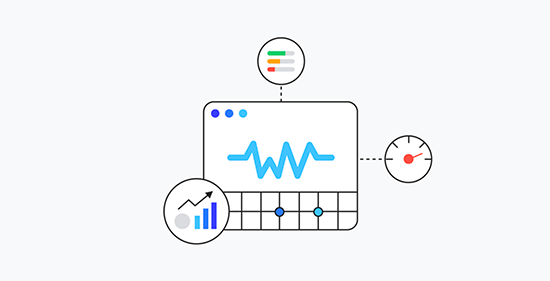
The Metrics that Matter
Core Web Vitals are a set of specific factors that Google considers essential in assessing a website’s user experience. Introduced as part of Google’s broader initiative to improve the quality of web pages, these vitals focus on three key aspects – loading performance, interactivity, and visual stability.
This article delves deep into the world of Core Web Vitals, exploring their significance, individual components, and the transformative impact they wield on both user satisfaction and search engine optimization (SEO).
Core Web Vitals
Core Web Vitals represent a subset of essential metrics that encapsulate critical aspects of user experience on the web. Comprising three key elements – Largest Contentful Paint (LCP), Interaction to Next Paint (INP), and Cumulative Layout Shift (CLS) – these metrics provide a comprehensive framework for assessing a website’s loading performance, interactivity, and visual stability.
- Largest Contentful Paint (LCP)
Largest Contentful Paint serves as a pivotal metric in gauging the loading performance of a web page. It measures the time it takes for the largest content element, be it an image, video, or other prominent feature, to become fully visible to the user. LCP is crucial because it directly correlates with the perceived speed of a website. Google recommends achieving an LCP of 2.5 seconds or less for optimal user experience.
How does LCP work?
LCP kicks in as soon as a user initiates the loading of a web page. The browser starts rendering the page’s content, and LCP is triggered when the largest content element is painted on the user’s viewport. LCP provides a tangible representation of how quickly a user can access the primary content of a page.
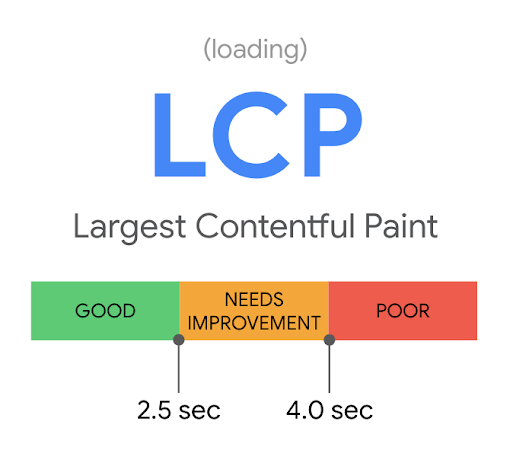
Strategies for Optimising LCP:
Optimise Critical Rendering Path:
Prioritise loading and rendering of critical resources. Optimise server response times, leverage browser caching, and use asynchronous loading for non-essential scripts to ensure that the largest contentful paint occurs as quickly as possible.
Compress and Deliver Images Efficiently:
Compress and deliver images in modern formats like WebP to reduce their file size without compromising quality. Use responsive image techniques to ensure that the appropriate image size is loaded based on the user’s device and screen size.
Leverage Content Delivery Networks (CDNs):
Implement a Content Delivery Network (CDN) to distribute content across geographically distributed servers. This reduces the physical distance between the user and the server, leading to faster content delivery and improved LCP.
- Cumulative Layout Shift (CLS)
Cumulative Layout Shift shines a spotlight on visual stability, measuring the amount of unexpected layout shifts that occur during a page’s loading process. CLS ensures that users are not disrupted by sudden changes in the page layout, promoting a smoother and more predictable browsing experience. A CLS score of 0.1 or less is deemed excellent.
How does CLS work?
CLS tracks the movement of elements on a page during its loading process. It calculates the impact of layout shifts by considering the area of the viewport affected and the distance the elements move. A lower CLS score indicates a more stable and user-friendly visual experience.
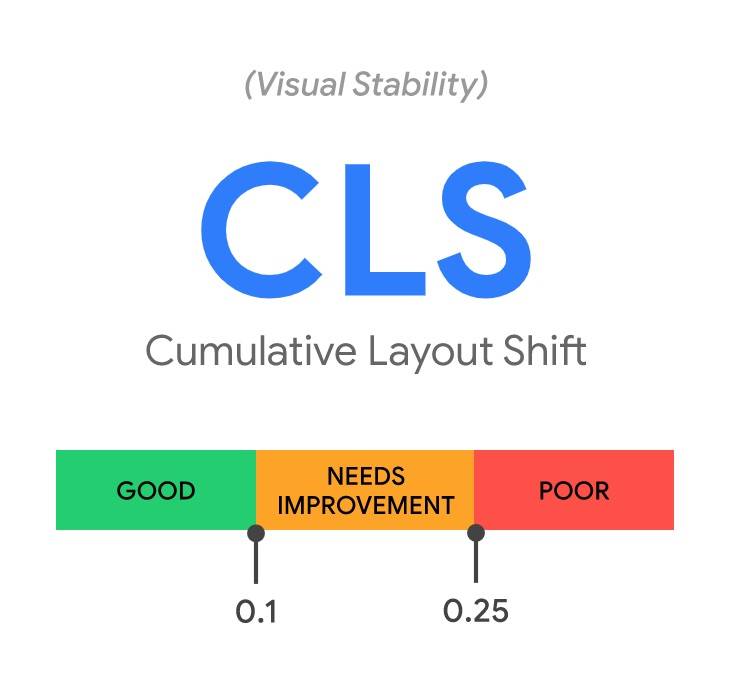
Strategies for Optimising CLS:
Set Dimensions for Media Elements:
Ensure that images, videos, and other media elements on your page have specified dimensions in the HTML. This helps the browser allocate the required space during rendering, reducing the chances of layout shifts when these elements load.
Prefer CSS Transforms for Animations:
When using animations, prefer CSS transforms over properties that can cause layout changes. Transforms, like translate and scale, typically don’t trigger layout shifts, providing smoother and more predictable user experiences.
Use Font Display Swap:
Implement the “font-display: swap;” CSS property for web fonts. This ensures that text remains visible during font loading, preventing sudden layout shifts when fonts are applied.
- Interaction to Next Paint (INP)
Interaction to Next Paint (INP) is a web performance metric designed to assess the responsiveness of a user interface, gauging how promptly a website reacts to user interactions such as clicks or key presses. This metric specifically quantifies the duration between a user-initiated interaction, like a click or key press, and the subsequent visual update that the user perceives on the page.
How does INP work?
INP comes into play when a user engages with a web page, measuring the duration between the user’s action and the website’s response. This metric is calculated when the user leaves the page, producing a singular value that represents the overall responsiveness of the page throughout its entire lifecycle.
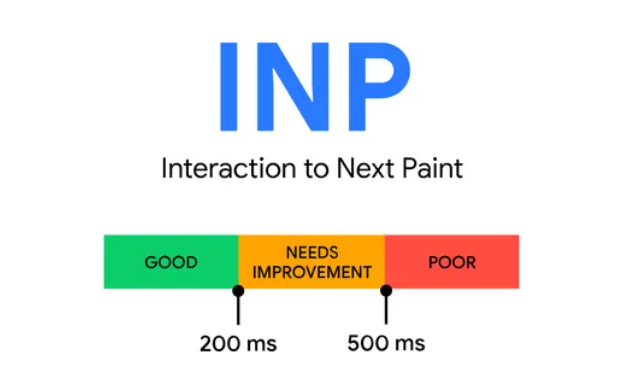
Strategies for Optimising INP:
Optimise JavaScript Execution:
Minimise and defer the loading of non-essential JavaScript to prevent it from blocking the main thread. Prioritise critical scripts and load others asynchronously. Utilise code-splitting techniques to only load the JavaScript necessary for the current user interaction.
Efficiently Manage Third-Party Scripts:
Limit the use of third-party scripts and only integrate those essential for core functionality. Evaluate the impact of each third-party script on input delay and consider loading them asynchronously or using techniques like sub-resource integrity (SRI) to ensure script integrity.
Implement Predictive Prefetching:
Anticipate user actions and prefetch or preload resources that might be required during subsequent interactions. This can be achieved by strategically prefetching content or utilising browser features like prefetch to load resources in the background.
Last year, Google announced that INP would be replacing First Input Delay (FID) as a Core Web Vital from March 2024 onwards.
Let us understand what FID was and how INP is different from it.
First Input Delay (FID):
First Input Delay (FID) measured the responsiveness of a webpage to user interactions. Specifically, FID quantifies the delay between a user’s first interaction, such as clicking a button or tapping on a link, and the browser’s response to that input. A good FID score indicates that the webpage responds promptly to user actions, contributing to an overall positive user experience. Slow FID scores can lead to frustration as users perceive unresponsiveness, negatively impacting user engagement and satisfaction.
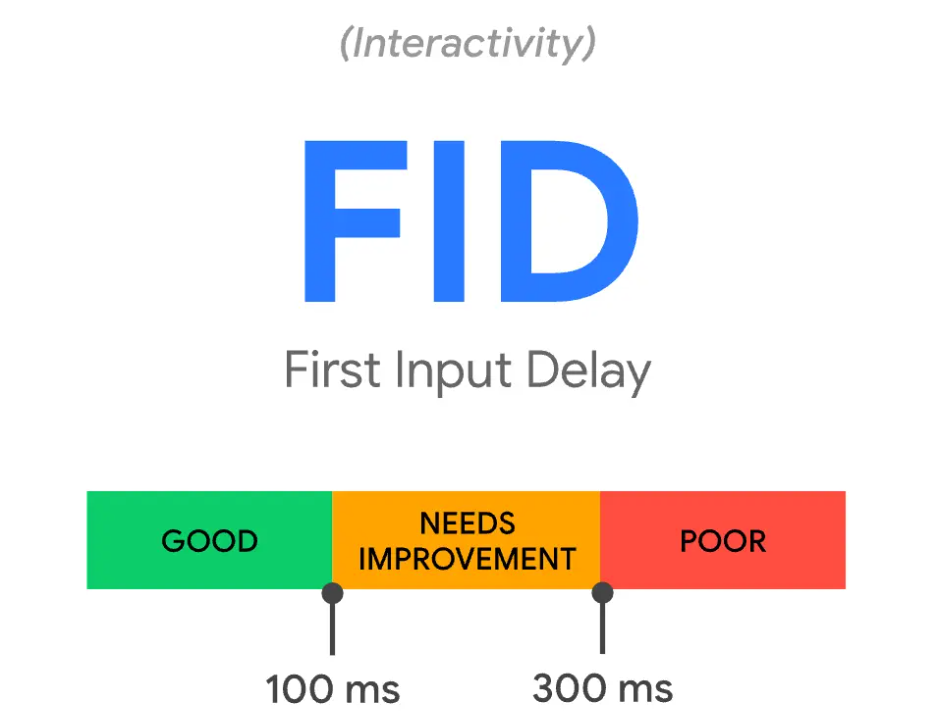
Contrast between FID and Input Delay (INP):
While FID and Input Delay (INP) both focus on measuring user interactions, they differ in their scope and application. FID specifically captures the delay associated with the first user input, providing insights into the initial interactivity of a webpage. On the other hand, INP is a broader metric that considers delays throughout the entire user interaction process. INP includes the delay for subsequent user inputs beyond the first, offering a more comprehensive view of the overall responsiveness of the webpage during a user’s entire session.
Table of Main Differences between FID and INP:
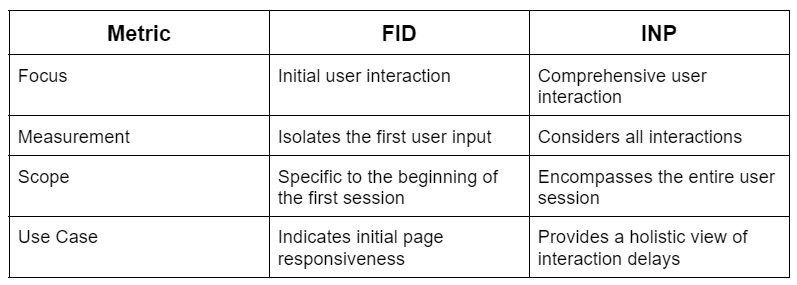
INP over FID as a metric:
Input Delay (INP) offers a more efficient and comprehensive measurement of user interaction delays compared to FID. While FID focuses on the first interaction, INP considers delays throughout the entire user session, giving developers and website owners a broader perspective on how responsive their site is across various interactions. This comprehensive view allows for a more accurate assessment of the overall user experience, helping to identify and address potential bottlenecks and areas for improvement. In essence, INP provides a more holistic understanding of a website’s interactivity, making it a valuable metric for optimising user engagement and satisfaction.

The SEO Nexus
While Core Web Vitals are intrinsically tied to enhancing user experience, their impact on SEO is equally significant. Google, the dominant force in search engines, has explicitly stated that these metrics are crucial ranking factors. Websites that prioritise and optimise for Core Web Vitals are more likely to ascend the ranks in search engine results, reaping the benefits of increased visibility and organic traffic.
Enhanced Search Rankings
Google’s algorithms are designed to reward websites that deliver exceptional user experiences. Core Web Vitals, with their focus on loading performance, interactivity, and visual stability, provide a tangible measure of user satisfaction. Websites that consistently meet or exceed the recommended thresholds for these metrics are aptly rewarded with higher search rankings.
Improved User Experience
Beyond its SEO implications, prioritising Core Web Vitals contributes significantly to an enriched user experience. Users are more likely to engage with websites that load swiftly, respond promptly to interactions, and maintain visual stability throughout their visit. A positive user experience not only reduces bounce rates but also fosters a sense of trust and satisfaction, encouraging users to explore further.
Mobile-Centric Optimization
As mobile devices continue to dominate the digital landscape, Google has shifted its emphasis to mobile-first indexing. Core Web Vitals, with their emphasis on responsive design and efficient loading on various devices, become paramount for success in the mobile-centric era. Websites that prioritise mobile-friendly experiences are well-positioned to thrive in the digital ecosystem.

In conclusion, Core Web Vitals represent a paradigm shift in the evaluation of web page performance. These metrics, encompassing Largest Contentful Paint, First Input Delay, and Cumulative Layout Shift, encapsulate the essence of user-centric design and efficient website development. As digital landscapes evolve and user expectations continue to rise, the importance of optimising for Core Web Vitals becomes increasingly evident.
By embracing strategies to enhance loading performance, interactivity, and visual stability, web developers and SEO practitioners pave the way for websites that not only meet the rigorous standards set by search engines but also captivate and retain the attention of users. In the ever-evolving journey of digital excellence, Core Web Vitals emerge as beacons guiding the way toward a future where user experience and SEO success converge seamlessly.






